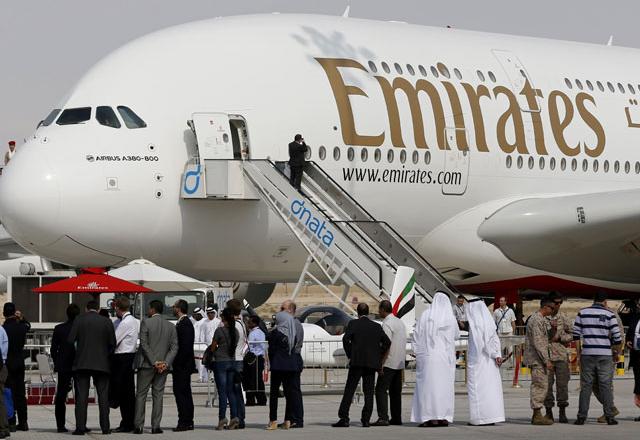You are here
A380 aimed high, but never hit cruising speed
By AFP - Feb 14,2019 - Last updated at Feb 14,2019

Airbus CEO Tom Enders, Sheikh Ahmed Bin Saeed Al Maktoum, chairman and chief executive of Emirates Airlines Group, and Louis Gallois, CEO of European Aeronautic Defence and Space Company, disembark from an A380 aircraft during a handover ceremony in Hamburg, on July 28, 2008 (Reuters file photo)
PARIS — Nearly 30 years ago Airbus began charting a new course for air travel with a mammoth jet that would shuttle hundreds of people to far-flung cities worldwide, but harsh economic realities eventually got the better of the A380 superjumbo.
After the plane's launch just over 11 years ago, the final two A380s will be delivered in 2021, Airbus said on Thursday, marking the end of an ambitious but ultimately misguided bet.
"The A380 was a strategic feat which put Airbus on equal footing with Boeing, by dethroning the 747," said Sebastian Maire, an aviation expert at the consulting firm Kea and Partners.
But from the start the huge double-decker struggled to get off the ground, causing headaches for executives as they tried to convince airlines to take a punt on how to move millions of passengers in the future.
The idea was to prepare for a surge in traffic as middle classes emerged in Asia and other developing regions, eager to join the growing ranks of business and leisure travellers as globalisation rippled across the globe.
With the A380 airlines would cut fuel costs and pollution by moving more passengers via fewer planes between major airports, where smaller aircraft would then bring them to their final destinations.
But this "hub and spoke" model would require huge investments by both airlines and airports, which had to lengthen and widen runways and hangers to accomodate the huge wingspans.
And in the end industry dynamics proved the opposite: airlines instead opted for more direct flights between more cities, using midsize planes like Boeing's hugely popular 787 Dreamliner.
"In 2000, when we took the decision to launch the A380, we didn't know what the market would look like 20 years later," Airbus's outgoing CEO Tom Enders told French daily Le Figaro in an interview on Thursday.
"It was a risky decision."
Hopes and headaches
Few would have imagined how it would all end when heads of state and industry executives gathered in January 2005 at the Airbus headquarters in Toulouse, southwest France, to celebrate the plane's first factory rollout.
The project dovetailed perfectly with the desire of European nations to build up their aerospace groups into a continental powerhouse, capable of taking on Boeing and other US rivals.
Ex-president Jacques Chirac treated the leaders of Britain, Germany and Spain to lunch after the glitzy unveiling, lauded as proof of Airbus's success.
Huge sections of the A380 would be built at Airbus factories spread across Europe before being transported to Toulouse for final assembly.
But the launch enthusiasm quickly faded as production snafus and missteps emerged, in part reflecting the difficulty in integrating national teams with different corporate cultures.
Electrical wiring proved especially vexing, leading to problems that would cost billions of euros to fix and a series of delivery delays.
Inaugural client Singapore Airlines had to wait an extra 18 months before finally launching the first commercial flight in October 2007.
While passengers raved about the quiet and spacious cabins, production delays continued, heightening concerns that the plane would turn out to be a white elephant.
'Our customers love it'
Despite an initial burst of orders mainly from Middle East and Asian clients, most airlines balked at the A380, which could be profitable only if every seat was sold on every flight.
The global financial crisis of 2007-08 put paid to that strategy, and made other airlines wary of committing to the costly plane, which currently has a list price of 446 million euros a piece.
Airbus managed to chalk up just over 320 orders for the A380, and had already slowed production in recent years before pulling the plug on Thursday.
"Our customers love the aircraft. It's very efficient in the way we operate and we are pleased with it," Willie Walsh, head of British Airways and Iberia parent IAG, said earlier this month.
But Walsh said the price tag was keeping him from adding to BA's fleet of 12 superjumbos.
"We have made it clear to Airbus that we might consider some additional aircraft, but it would only be at a price that we would find attractive," he said.
Boeing, by contrast, has seen its bet on the smaller but more fuel efficient Dreamliner, garnering more than 1,100 orders since it entered service in 2011.
At a conference call with Airbus management Thursday, few analysts dwelled on the A380's failure, instead congratulating the company on the robust 29 per cent jump in 2018 profits.
"We often praise the ability of new-economy companies, especially American ones, to quickly take decisions and experiment with new ideas," said Philippe Plouvier, an associate at the Boston Consulting Group.
"It would be a mistake to criticise Airbus for exploring a new frontier in aerospace, and then decide to move on to something else," he added.
Related Articles
PARIS — Emirates Airlines on Thursday said it has struck a $16 billion deal to buy 36 Airbus A380 superjumbos just days after the European m
Airbus said Tuesday it beat Boeing with 1,456 net orders last year, but despite handing over a record 629 planes to airlines in 2014 it is still trailing its US rival in deliveries of commercial passenger jets.
DUBAI — Tim Clark, president of Emirates, the Middle East’s biggest carrier, will step down from his position after 16 years in June 2020, t













